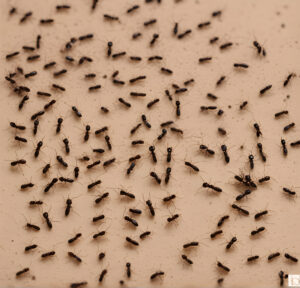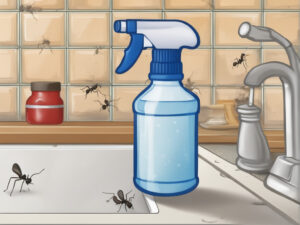Flying ants, often referred to as alates, are a common sight during specific times of the year. While these winged insects are intriguing to observe, questions frequently arise regarding flying ant bites and their consequences. In this all-encompassing guide, we will delve into all your queries about flying ant bites and how to handle them.
Flying Ant Bites: Questions Answered
1. Do flying ants bite humans?
Yes, flying ants can indeed bite humans. It’s important to note that flying ants are distinct from worker ants, which are generally non-threatening. However, flying ants possess the capability to bite humans, often as a defense mechanism.
Yes, Flying Ants Can Bite: Flying ants, like their wingless counterparts (worker ants), are capable of biting humans. They have mandibles or jaws designed for a variety of tasks, including biting and chewing.
Biting Behavior: Flying ants may bite when they feel threatened or provoked. This can happen if you accidentally disturb their nest or if they perceive you as a potential threat. Biting is a defensive response for them.
Mating Swarms: One of the most common scenarios where flying ants interact with humans is during mating swarms. When reproductive ants, known as alates, take flight to mate, they can sometimes land on or come into contact with people. While they may not intentionally bite humans in these situations, they can inadvertently bite if they feel trapped or cornered.
Stinging vs. Biting: It’s important to distinguish between stinging and biting insects. Some ants, like fire ants, are known for their stinging rather than biting. Stings are typically more painful and can cause allergic reactions in some individuals. Flying ants typically bite, and their bites are generally less painful compared to stings.
Defense Mechanism: Biting is a last-resort defense mechanism for flying ants. They would generally prefer to escape or fly away rather than engage in biting humans. However, if they perceive a threat and have no other option, they may bite.
Bites Are Mild: Flying ant bites are usually considered mild, and the discomfort they cause is often temporary. Common symptoms include redness, itching, swelling, and mild pain at the bite site.
Infrequent Biting: It’s important to note that flying ant bites are relatively infrequent and not a common occurrence in most people’s lives. While they can happen, many people may never experience a flying ant bite.
In summary, flying ants can bite humans, but their bites are generally mild and infrequent. These ants prefer flight and evasion over confrontation, so they usually only bite when they feel cornered or threatened. If you do get bitten by a flying ant and experience any unusual or severe reactions, it’s advisable to seek medical attention.

2. Are flying ant bites painful?
Generally, flying ant bites are not overly painful. However, the level of discomfort associated with these bites can vary depending on an individual’s sensitivity and the specific species of the flying ant in question.
3. What do flying ant bites look like?
Flying ant bites typically manifest as small, reddish, or itchy bumps on the skin. They may resemble other insect bites, such as mosquito bites or bee stings.
Redness: Flying ant bites often result in redness around the affected area. This redness may appear within a few hours of being bitten and can vary in intensity depending on the individual’s skin sensitivity.
Swelling: Swelling is a common reaction to flying ant bites. The degree of swelling can range from mild to moderate, depending on the person’s sensitivity to the ant’s venom. It typically occurs around the bite site and may extend slightly beyond it.
Itching: One of the hallmark signs of flying ant bites is itching. The bites can be intensely itchy, leading to discomfort and a strong urge to scratch. Scratching should be avoided as it can lead to secondary infections.
Raised Bumps or Pustules: Flying ant bites may present as raised, small bumps or pustules. These can be filled with clear fluid and can be painful to touch. Over time, the fluid may become cloudy or yellowish.
Central Puncture Mark: Some flying ant bites may have a central puncture mark at the site of the sting. This mark can be tiny and may resemble a small, dark dot. It is where the ant’s stinger or mouthparts penetrated the skin.
Clustered Bites: In some cases, you may notice multiple flying ant bites clustered closely together, forming a small group of bites. This can happen when ants swarm or bite repeatedly in a localized area.
Inflammation: The bitten area may become inflamed, with the skin around the bite site appearing slightly raised or puffy.
Pain: While itching is a common symptom, some individuals may also experience pain or discomfort at the bite site. Pain levels can vary depending on individual sensitivity.

4. How should you treat flying ant bites?
Wash the Affected Area: The first step in treating flying ant bites is to clean the bitten area thoroughly. Use mild soap and lukewarm water to wash the bite site. Gently pat the area dry with a clean towel.
Apply an Antiseptic: After cleaning, apply an antiseptic solution to the bite. Antiseptics like hydrogen peroxide or rubbing alcohol can help prevent infection. Dab a small amount onto a cotton ball or pad and gently press it onto the bite.
Reduce Swelling with Cold Compress: If the bite area is swelling or painful, you can apply a cold compress. Wrap some ice or a cold pack in a thin cloth and place it on the bite for about 10-15 minutes. This can help reduce inflammation and ease discomfort.
Use Over-the-Counter Anti-Itch Cream: If itching persists, you can apply over-the-counter anti-itch creams or ointments. These products often contain ingredients like hydrocortisone, which can provide relief from itching and inflammation. Follow the instructions on the product label for proper application.
Avoid Scratching: One of the most important steps in treating flying ant bites is to resist the urge to scratch the affected area. Scratching can introduce bacteria and increase the risk of infection. If itching becomes unbearable, using an anti-itch cream as mentioned earlier is a safer option.
Oral Antihistamines: For severe itching or allergic reactions, oral antihistamines like Benadryl (diphenhydramine) can be helpful. These medications can relieve itching and reduce allergic responses. Consult a healthcare professional for the appropriate dosage and guidance.
Watch for Allergic Reactions: While flying ant bites are usually not dangerous, some individuals may experience allergic reactions, ranging from mild to severe. Signs of a severe allergic reaction may include difficulty breathing, swelling of the face or throat, dizziness, or a rapid heartbeat. If any of these symptoms occur, seek immediate medical attention.
Monitor the Bite: Keep an eye on the bite for signs of infection. If the bite becomes increasingly red, swollen, painful, or if you notice discharge, consult a healthcare professional promptly. Infection may require antibiotic treatment.

For additional info about ant bites, you can see the Cleveland Clinic page on ant bites.
5. Are flying ant bites dangerous?
In most cases, flying ant bites are not dangerous. However, it’s important to be aware that some individuals may experience allergic reactions to these bites, which can occasionally be severe. If you suspect an allergic reaction, it is crucial to seek immediate medical assistance.
6. What distinguishes flying ant bites from other insect bites?
Flying ant bites may bear similarities to other insect bites, such as those from mosquitoes or bees. However, the specific appearance and symptoms of flying ant bites can vary, which is why proper identification is essential.
7. Why do flying ants bite?
Flying ants resort to biting as a form of self-defense when they perceive a threat. They employ their mandibles to bite, and their saliva may contain irritants that induce itching and discomfort in the affected area.
8. Do all flying ants bite, or is it characteristic of specific species?
Not all flying ants exhibit a propensity to bite, and the likelihood of biting can differ among various species. Some species are more prone to biting when compared to others.
9. What measures can be taken to prevent flying ant bites?
To minimize the risk of flying ant bites, it is advisable to avoid provoking or handling these insects. When encountering a swarm of flying ants, maintaining composure and slowly moving away from the area is a recommended approach. Wearing long-sleeved clothing can also provide some protection against bites.
10. What constitutes the most effective remedy for flying ant bites?
The most effective remedy for flying ant bites entails thoroughly cleaning the affected area with soap and water. Following cleaning, the application of an antiseptic is recommended to reduce the risk of infection. For persistent itching, anti-itch creams or over-the-counter remedies may be employed. In instances of severe reactions, it is advisable to consult with a healthcare professional.
Have Ants Around Your Home? Check out our Helpful Guides
-
How To Kill Ants With Boric AcidHow To Kill Ants With Boric Acid
-
How to Kill Ants with Soap and WaterHow to Kill Ants with Soap and Water
Sources: WebMD – What to Know about the Flying Ant




